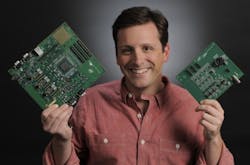Greenbelt, MD--NASA researcher Jonathan Pellish, a researcher at NASA's Goddard Space Flight Center, is working on a computing technology of yesteryear—analog, rather than digital, data processing—as an approach to more-quickly calculate fast Fourier transforms (FFTs) for optical wavefront sensing and control, among other applications. The technology relies on an analog-based microchip developed with significant support from the Defense Advanced Research Projects Agency (DARPA).
The device is being fabricated at a Cambridge, Mass.-based company, Analog Devices Lyric Labs. Among other products, the company has developed an analog-based integrated circuit geared specifically for computing Fourier transforms. The NASA team will use the technology, which the company donated, to assemble several custom circuit boards. “We’ll take the hardware and see what it can do with our data and applications,” Pellish explained.
So convinced is he of its potential, Pellish is meeting with scientists and engineers to explain the technology’s capabilities and is using fiscal year 2013 NASA Center Innovation Fund resources to have the printed circuit boards built, so that researchers can use to test the technology’s performance for a range of scientific applications. He also has carried out preliminary radiation-effects studies to see how the technology’s architecture holds up under the extreme environment encountered in space.
“I think this technology could fundamentally change the way we carry out onboard processing," says Pellish. Due to its analog nature, the microchip can perform a calculation more efficiently, with fewer circuits and less power than a digital processor -- attributes important for space- and power-constrained spacecraft instruments, Pellish notes. (Although “there has been an overwhelming amount of positive support for the technology within Goddard” since Pellish began introducing colleagues to its capabilities, he is the first to concede that the technology isn’t appropriate for all space applications.)
FFT for other uses, too
Jeffrey Klenzing, who works with Goddard’s Space Weather Laboratory, wants to evaluate the technology’s use for on-board data processing, particularly for studies of the sun. “For a typical sounding rocket application, we send all data down and perform fast Fourier transforms on the ground. However, for satellite missions, this is not feasible given limited telemetry,” Klenzing said. “A chip for performing rapid, reliable FFTs would be very useful for such heliophysics missions, particularly with the push toward smaller, low-power satellites such as CubeSats and nanosats.”
Source: http://www.nasa.gov/topics/technology/features/analog-microchip.html

